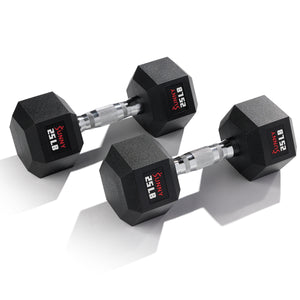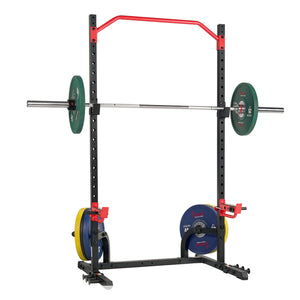Functional training might sound like another fad workout, but in reality, incorporating intentional exercises into your workout can improve strength, stability, and mobility. Functional training is all about training your body for everyday activities, like lifting an object from the floor, loading your luggage into an overhead bin on a plane, or jumping to the side to get out of the way when navigating public spaces.
What is Functional Training?
Functional fitness simply prioritizes natural movements over exercises that are done with a machine or have little practical use. Functional training is exercises that are completed in a certain way to mimic natural movements and activities that take place outside the gym. The purpose is to get your body to move through diverse movement patterns, focusing on compound exercises that recruit multiple muscles and joints to work together. (1) These are movement patterns with a purpose. Movements like squats or pull-ups are considered more functional than using a leg press or lat pulldown machine. The exercises parallel with everyday activities like squatting, sitting, standing up, walking, picking up a heavy object, or pushing open a door.
What Are the Benefits of Functional Training?
1. Healthier Movement Patterns
Your body was designed for certain movement patterns that help keep your muscles in balance. Intentionally training these movement patterns can prevent tension, pain, or muscular imbalances. These exercises don’t just isolate one muscle action but instead incorporate multiple muscle groups at once for movement efficiency. A few human movement patterns include basic moves like the hip hinge, squat, lunge, push, pull, or rotation. (2)
2. Improved Physique
Since functional training recruits multiple muscle groups at once, it can help develop a leaner, toned, more athletic-looking body. Obviously, when you exercise regularly, the result is a stronger body. Functional training is also great for weight loss because you’ll typically burn more calories by doing compound exercises.
3. Improved Coordination, Body Awareness, and Mobility
Functional training exercises improve overall coordination and mobility. Mobility is the ability to move purposefully through each joint’s full range of motion, freely and efficiently. When muscles on one side of a joint are shortened, they cause the muscles on the other side to lengthen. (3) This in turn hinders the joint's ability to move the way it’s intended to. Integrated movement patterns like pushing, pulling, squatting, or standing up can improve joint mobility while enhancing overall muscle coordination.
How to Incorporate Functional Training?
The best part about incorporating functional training into your routine is that it is completely customizable allowing for beginner, intermediate, and advanced training moves to spice up your workout no matter your fitness level. These basic exercises can also be enhanced by using elastic bands, medicine balls, ropes, kettlebells, sandbags, and even tires.
Here is a list of valuable moves that will improve body awareness, movement patterns, and full body power. Beginners can perform 8-12 reps and 1-2 sets, intermediate exercisers can perform 12-15 reps and 2-3 sets, and advanced exercisers can do 15 reps and 3-4 sets. (4)
Pull-ups
Muscles Activated: Lats, upper back, middle back, biceps
Incorporating pull-ups into your fitness routine may seem like an impossible task, but many accommodations can be made to make this exercise accessible for any fitness level. Pull-up variations using a 41” loop resistance band or an assisted pull-up machine are a great place to start. This is the perfect way to include this exercise in your routine if a traditional pull-up isn’t doable for you just yet. Engaging the muscles in your back (latissimus dorsi, trapezius and rhomboids), shoulders (deltoids and rotator cuff), arms (biceps), and core (rectus abdominis and the transversus abdominis), bend your elbows as you lift your body up, raising your chin or chest above the level of the bar. (5)
Woman Maker/Man Maker
Muscles Activated: Quads, hamstrings, glutes, lats, upper back, middle back, chest, shoulders
This move is a body-blasting combination of several functional movements, including a burpee, renegade row, push-up, squat clean, and overhead press. This exercise requires a good connection to your core and gluteal muscles and requires you to be conscious of each movement. To ensure you aren’t overcompensating in muscle groups that should not be activated, move slowly. If this is your first time doing this exercise, try breaking down each individual move first to ensure proper form, before combing the movements. (5)
Sled Pull/Push
Muscles Activated: Glutes, quads, hamstrings, calves, middle back, lats, chest, shoulders, triceps, biceps
This exercise may sound easy, but it can quickly turn into one of the most challenging parts of your workouts. You simply load the sled up with your chosen amount of weight, then either push or pull it for a certain distance. While highly demanding, it is also a joint-friendly exercise that can improve conditioning. The best part of this exercise is that it is adaptable to all fitness levels and ages.(6)
One Arm Kettle Bell Snatch
Muscles Activated: Back, shoulders, traps, glutes, quads, hamstrings
The kettlebell snatch is a full-body, power exercise working almost every major muscle in one movement. This movement requires coordination between the legs, hips, core, back, and shoulders generating the necessary power to lift the kettlebell overhead. Since the kettlebell is being lifted overhead, it takes a significant amount of shoulder stability. This can help improve shoulder health and increase overall shoulder mobility. Since this is a unilateral exercise, meaning it works one side of the body at a time, it can help address any muscle imbalances and enhance core stability. (7)
Jump Squat
Muscles Activated: Quadriceps, hamstrings, glutes, calves, shoulders
Jump squats are a dynamic exercise that improves strength, power, endurance, and explosiveness. When you squat, your hip, knee, and ankle joints work through flexion and extension. Your glutes and quads, the working muscles, drive movement while supported by hamstrings, calves, and erector spinae which act as synergists. Jump squats can help reduce your risk of injury by strengthening your leg muscles and improving your overall lower body stability. (8)
Dumbbell Thruster
Muscles Activated: Quadriceps, glutes, hamstrings, shoulders, triceps, core
Alongside the Woman Maker/ Man Maker, the dumbbell thruster is a grueling but efficient, functional full-body movement. The thruster is essentially a combination of two lifts: the front squat and the push press. This compound movement uses a combination of balance, coordination, flexibility, strength, and endurance. The mechanics of the movement require your major joints to move from full flexion to full extension. (9)
Push up
Muscles Activated: Shoulders, chest, triceps, traps, core, biceps
Push ups are a compound exercise that engages multiple muscle groups at once. This is a great way to strengthen the muscles of your upper body. The muscles activated in this movement directly parallel movements done in your daily life. You rely on these muscles for many activities, from picking things up to pushing a shopping cart. (10)
Functional training may not focus on building the biggest muscles, but they are essential for building a baseline of functional strength and mobility. This allows you to perform various other exercises more effectively in your training routine and, more importantly, move through your life with more ease.
1-2,4. Mahaffey, K. (2022). Functional training: Compound workouts for fitness. National
Academy of Sports Medicine. https://blog.nasm.org/functional-training-compound-workouts. Accessed 21 August 2023.
3. McCall, P. (2019). 8 benefits of functional training. Core Health & Fitness.
https://corehandf.com/8-benefits-of-functional-training/. Accessed 21 August 2023.
5. Berg, M. (2022). The world’s 10 best functional exercises. Oxygen.
https://www.oxygenmag.com/workouts-for-women/total-body-workouts-for-women/the-worlds-10-best-functional-exercises/. Accessed 21 August 2023.
6. McLean, S. (2022). Sled push & pull: Benefits, muscles worked & exercise variations. Set for
Set. https://www.setforset.com/blogs/news/sled-push-pull-exercises. Accessed 21 August 2023.
7. Well Built Kettlebells. (2021). Unleashing the ultimate athlete. Well Built Kettlebells. https://wellbuiltkettlebells.com/unleashing-the-ultimate-athlete-the-power-of-the-1-arm-kettlebell-snatch/. Accessed 23 August 2023.
8. American Sports and Fitness Association. (2020) The top 10 benefits of jump squats.
American Sports and Fitness Association.
https://www.americansportandfitness.com/blogs/fitness-blog/the-top-10-benefits-of-jump-squats. Accessed 23 August 2023.
9. Frei, L. (2021). Thrusters 101: An unbeatable full-boy experience. Trainheroic.
https://www.trainheroic.com/blog/thrusters/. Accessed 23 August 2023.
10. Eresman, k. (2022). 7 science-backed benefits of doing push-ups. GoodRx Health.
https://www.goodrx.com/well-being/movement-exercise/benefits-of-push-up. Accessed 23 August 2023.


























Add Your Name & Email
Please enter your name and email to continue.We won’t display your email publicly.
1 comment
Great information !